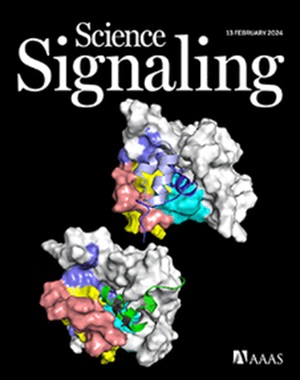The MDM2-p53 axis regulates norrin/frizzled4 signaling and blood-CNS barrier function
IF 6.6
1区 生物学
Q1 BIOCHEMISTRY & MOLECULAR BIOLOGY
引用次数: 0
Abstract
Norrin-induced activation of β-catenin–dependent signaling through the receptor frizzled4 in endothelial cells (ECs) is essential for establishing and maintaining blood-CNS barrier function. We sought to determine how this pathway is modulated under stress or disease conditions. Specifically, we investigated the role of p53 in endothelial blood-CNS barriers because increased abundance of the transcription factor p53 in ECs correlates with leaky CNS blood vessels in type 2 diabetes. Using transcriptomic, cell-based, and mouse genetic approaches, we identified interplay between p53 and its negative regulator MDM2 and norrin/frizzled4 signaling. Mice with an EC-specific ablation of Mdm2 showed decreased norrin/frizzled4 signaling, reduced EC proliferation and retinal angiogenesis, and disrupted blood-retina barrier function, all of which were largely restored by concurrent Trp53 deletion. Decreased norrin/frizzled4 signaling and inhibition of EC proliferation in response to p53 were associated with reduced expression of the condensin I complex component non-SMC condensin I complex subunit H (NCAPH). This study identifies a regulator of norrin/frizzled4 signaling and suggests that the clinical use of MDM2 inhibitors might impair the blood-CNS barrier. In addition, NCAPH may be a downstream effector of p53 in ECs and a candidate gene for familial exudative vitreoretinopathy (FEVR), which is caused by defects in norrin signaling.

MDM2-p53轴调节norrin/ zzzzled4信号和血液-中枢神经系统屏障功能
norrin诱导的β-catenin依赖性信号通过内皮细胞(ECs)受体zzzzled4激活,对于建立和维持血液-中枢神经系统屏障功能至关重要。我们试图确定这种途径在压力或疾病条件下是如何调节的。具体来说,我们研究了p53在内皮血液-中枢神经系统屏障中的作用,因为内皮细胞中转录因子p53丰度的增加与2型糖尿病患者的中枢神经系统血管渗漏有关。利用转录组学、细胞基础和小鼠遗传学方法,我们确定了p53与其负调节因子MDM2和norrin/ zzzzled4信号之间的相互作用。Mdm2消融EC特异性小鼠显示norrin/ zzzzled4信号减少,EC增殖和视网膜血管生成减少,血视网膜屏障功能破坏,所有这些都通过同时删除Trp53而基本恢复。norrin/ zzzzled4信号的减少和EC增殖的抑制与凝缩蛋白I复合物组分非smc凝缩蛋白I复合物亚基H (NCAPH)的表达减少有关。本研究确定了norrin/ zzzzled4信号的调节因子,并提示临床使用MDM2抑制剂可能会损害血液-中枢神经系统屏障。此外,NCAPH可能是ECs中p53的下游效应因子,也是家族性渗出性玻璃体视网膜病变(FEVR)的候选基因,FEVR是由norrin信号缺陷引起的。
本文章由计算机程序翻译,如有差异,请以英文原文为准。
求助全文
约1分钟内获得全文
求助全文
来源期刊

Science Signaling
BIOCHEMISTRY & MOLECULAR BIOLOGY-CELL BIOLOGY
CiteScore
9.50
自引率
0.00%
发文量
148
审稿时长
3-8 weeks
期刊介绍:
"Science Signaling" is a reputable, peer-reviewed journal dedicated to the exploration of cell communication mechanisms, offering a comprehensive view of the intricate processes that govern cellular regulation. This journal, published weekly online by the American Association for the Advancement of Science (AAAS), is a go-to resource for the latest research in cell signaling and its various facets.
The journal's scope encompasses a broad range of topics, including the study of signaling networks, synthetic biology, systems biology, and the application of these findings in drug discovery. It also delves into the computational and modeling aspects of regulatory pathways, providing insights into how cells communicate and respond to their environment.
In addition to publishing full-length articles that report on groundbreaking research, "Science Signaling" also features reviews that synthesize current knowledge in the field, focus articles that highlight specific areas of interest, and editor-written highlights that draw attention to particularly significant studies. This mix of content ensures that the journal serves as a valuable resource for both researchers and professionals looking to stay abreast of the latest advancements in cell communication science.
 求助内容:
求助内容: 应助结果提醒方式:
应助结果提醒方式:


